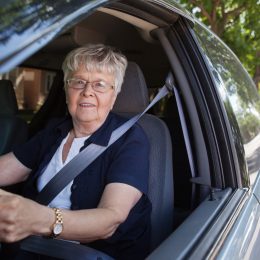
As we age, certain physical and cognitive changes may impact our ability to drive safely. While driving provides independence and freedom, it is essential to prioritize safety for the elderly driver and others on the road. Recognizing the signs that it may be time to stop driving and approaching your loved one with concerns for their safety can be a sensitive but necessary conversation. Today we will explore the driving risks for your aging loved one, signs to look for, and strategies for addressing this delicate topic.
Driving risks for aging adults stem from various age-related factors. These include diminished vision, slower reaction times, reduced cognitive function, and physical limitations. Not all elderly individuals will experience these changes to the same extent, and some may continue to drive safely well into their later years. However, it is crucial to remain vigilant and consider the following signs that may indicate it’s time to reassess their driving abilities:
- Vision problems: If your loved one experiences difficulty reading road signs, judging distances, or has frequent near misses, it may indicate vision-related issues that can impair their driving.
- Slower reaction times: Age can affect reflexes and response times. If your parent consistently reacts slowly to unexpected situations, such as abrupt stops or lane changes, it could be a cause for concern.
- Frequent dents and scratches: If their vehicle frequently shows signs of minor accidents or damages, it might indicate diminished driving skills or difficulty maneuvering the vehicle safely.
- Getting lost or confused: Memory lapses, difficulty following directions, or getting disoriented in familiar places can jeopardize their ability to navigate and respond appropriately to traffic.
- Physical limitations: Arthritis, reduced mobility, and muscle weakness can affect their ability to control the vehicle, turn the steering wheel, press the pedals, or look over their shoulder for blind spots.
- Increased anxiety or fear: A noticeable increase in anxiety or fear while driving, especially in routine situations, may indicate a decline in confidence and competence behind the wheel.
Having identified these signs, it is important to address your concerns for the safety of your loved ones while driving. Here are some strategies to approach the conversation sensitively:
- Choose an appropriate time and place: Find a calm and relaxed environment to discuss the topic. Avoid bringing up the issue during or immediately after a stressful driving incident.
- Express your love and concern: Begin the conversation by emphasizing your love and care for them. Explain that your primary concern is their safety and the safety of others on the road.
- Use concrete examples: Share specific instances or observations that have caused you concern. This helps provide context and allows your loved one to understand the reasons behind your worries.
- Offer alternatives and support: Assure your loved one that giving up driving doesn’t mean giving up independence. Discuss alternative options like public transportation, ride-sharing services, or family members/friends who can provide rides when needed.
- Suggest a driving evaluation: Recommend a professional driving assessment to determine their current abilities objectively. This evaluation can help identify areas of concern and provide guidance on whether they can continue driving safely or need to make adjustments.
- Involve other family members or professionals: If your loved one resists your concerns, involving other family members, close friends, or healthcare professionals can provide additional perspectives and support.
Remember, this conversation may take time, and your loved one may initially resist the idea of giving up driving. Being patient, empathetic, and understanding is essential while addressing their concerns and fears. Ultimately, prioritizing their safety and the safety of others on the road should be the driving force behind these discussions.

